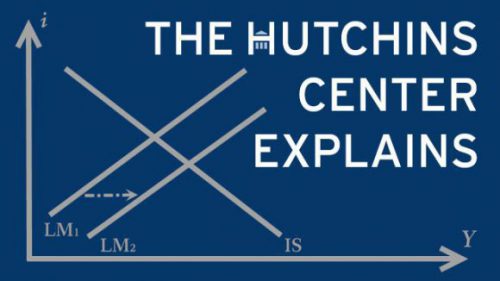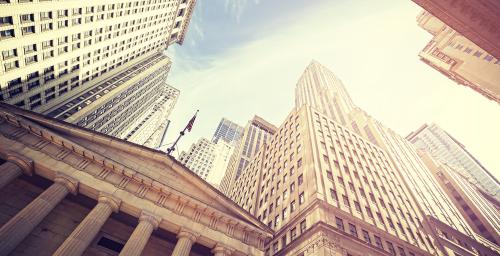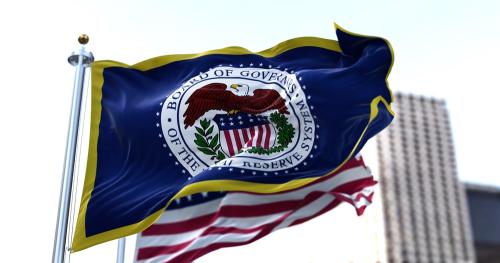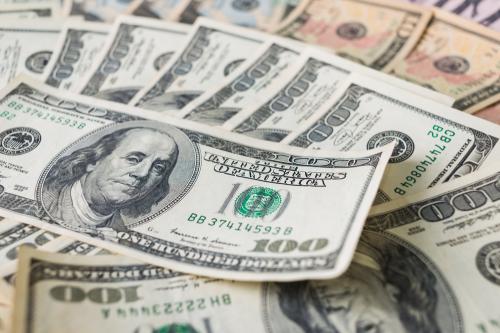At the onset of the pandemic in March 2020, the Federal Reserve began increasing its balance sheet by buying large quantities of Treasury debt and mortgage-linked securities (known as quantitative easing, or QE). It began reducing its balance sheet gradually (known as quantitative tightening, or QT) in June 2022 by not reinvesting all the proceeds of maturing securities. As of the end of March 2024, the Fed had reduced its assets from a peak of nearly $9 trillion to $7.4 trillion. On May 1, 2024, the Fed said that, beginning in June, it will slow the pace of the decline in its Treasury securities portfolio to $25 billion a month, down from the previous pace of $60 billion a month. At some point, probably in 2024 or early 2025, the Fed will stop shrinking its balance sheet altogether. This post explains how the Fed will decide when to end QT, how its “ample reserves” framework works, and what a Fed program called Overnight Reverse Repurchases (ON RRP) has to do with all of this.
What has the Fed said about its plans to stop shrinking its balance sheet?
In January 2022, the Federal Open Market Committee (FOMC), the Fed’s policy-making body, listed several principles for reducing its balance sheet. Among them was this: “Over time, the Committee intends to maintain securities holdings in amounts needed to implement monetary policy efficiently and effectively in its ample reserves regime.” At his December 2023 press conference, Fed Chair Jerome Powell said the plan is to “slow and then stop the decline in the size of the balance sheet when reserve balances are somewhat above the level judged to be consistent with ample reserves.” (More on ample reserves below.)
What are reserves?
Reserves are funds that banks deposit at the Fed (plus the cash in bank vaults). No other asset is as safe or as liquid. Banks use them during the day to settle payments between banks or between customers of different banks. Banks hold reserves so they always have liquid assets that can be tapped if they confront a large outflow of deposits and to satisfy liquidity regulations and supervisory guidance.
How has the role of reserves in monetary policy changed?
The Fed’s main lever for steering the economy is adjusting short-term interest rates— particularly the federal funds rate. That’s the rate banks charge each other for overnight loans, and it’s also a benchmark for other short-term rates. Before the Global Financial Crisis, the Fed used changes in the supply of reserves to influence the federal funds rate in what is known as a scarce reserves regime. In that era, banks held as few reserves as possible, in part because back then the Fed didn’t pay interest on those deposits. The Fed actively managed the quantity of reserves in the financial system by buying and selling short-term U.S. Treasuries on a daily basis.
When the Fed buys Treasuries or other securities, it pays the sellers of those securities with checks drawn on itself. When the sellers deposit those checks at their banks, those claims on the Fed become new reserves in the banking system. In short, the Fed’s buying of securities creates bank reserves. When the Fed sells Treasuries, the process works in reverse, and bank reserves decline. Increases in the supply of reserves tend to push down the fed funds rate (the price of reserves) and other interest rates, while decreases in the supply of reserves raise interest rates. In the days before the Global Financial Crisis, the Federal Reserve Bank of New York, which manages the Fed’s money market operations, carefully monitored banks’ fluctuating demand for reserves and adjusted the Fed’s daily purchases and sales of securities (open market operations) to keep the fed funds rate close to the target level set by the FOMC.
All that changed during the Global Financial Crisis in 2008. The crisis was followed by the Great Recession, which the Fed tried to fight by pushing short-term interest rates down almost to zero. That proved insufficient to shore up the struggling economy. Accordingly, the Fed began purchasing large quantities of long-term government bonds and mortgage-backed securities (QE) with the goal of pushing down long-term interest rates, which had remained above zero. Long-term rates are important because they influence mortgage rates and the rates that businesses pay to borrow. When the Fed bought the longer-term bonds, it created bank reserves. (From an accounting perspective, bonds the Fed holds sit on the asset side of its balance sheet. Increasing assets (QE) must be matched by increasing liabilities, mainly reserves and currency. Shrinking assets (QT) must be matched by reducing liabilities.)
In conjunction with its adoption of QE in 2008 and 2009, the Fed moved to an ample reserves regime in which banks hold substantial quantities of reserves. Banks were willing to do so because the Fed started paying interest on those reserves. The switch to ample reserves and the Fed’s payment of interest changed how the Fed controls short-term interest rates. Today, the Fed no longer influences the fed funds rate by injecting or withdrawing reserves every day, but instead administratively puts a floor on short-term rates by the interest rate it pays banks on their reserve deposits (commonly known as the Interest on Excess Reserves Rate, or IOER)1 and the interest rate it pays other money market funds and other financial institutions on their deposits with the Fed (the Overnight Reverse Repo Facility, or ONRRP, rate, discussed below). Most central banks outside the U.S. use a similar approach to control short-term rates.
(A regime in which banks hold far more reserves than necessary to meet legal requirements and banks’ demand for liquidity buffers is known as abundant reserves regime. The U.S. is effectively in an abundant reserves situation now, but the Fed’s stated policy is to move to an ample reserves regime.)
As long as the Fed was keeping short-term interest rates at zero, a financial system flush with reserves didn’t pose any challenges to its ability to steer the economy. But in 2015, the Fed wanted to begin raising interest rates. Buying and selling modest amounts of reserves—traditional open market operations—would have little influence when reserves are so plentiful. The Fed, accordingly, relied on raising the IOER and the ON RRP to lift short-term rates.
So how does the Fed decide what is “ample”?
In an ample reserves regime, the Fed supplies enough reserves so that the fed funds rate (where demand for reserves equals supply) changes very slightly when the quantity of reserves in the banking system changes. To help determine when reserves are sufficient—that is, when reserves aren’t scarce—the Fed monitors short-term interest rates in money markets, such as rates in the repo market, an important market in which one institution lends another money for a very short-term period collateralized by U.S. Treasury securities. The Fed anticipates that banks with lots of reserves will use them to lend in the repo market when rates there rise, which smooths out sharp movements. If banks are reluctant to use their reserves to lend into the repo market even when repo rates are unusually high, that’s a sign that banks feel they don’t have reserves to spare—that is, reserves are not ample.
A 2019 episode shows the challenge the Fed faces in figuring out how ample reserves are. As the Fed shrank its balance sheet from October 2014 to September 2019, the level of bank reserves fell to around $1.5 trillion. The Fed believed that would leave the banking system with sufficiently ample reserves. That proved wrong, as the Fed learned when short-term rates in money markets shot up in September 2019 and banks held onto reserves instead of using them to lend at attractive interest rates. In response, the Fed again began increasing reserves and the size of its balance sheet.
Over the past couple of decades, the quantity of reserves that banks consider ample has risen because of more stringent liquidity regulation and because banks want larger cash buffers in the wake of the Global Financial Crisis. (For more on this, see this New York Fed post.) In August 2023, St. Louis Fed economists Amalia Estenssoro and Kevin L. Kliesen suggested that, given the evolution of financial markets, reserves equal to 10% to 12% of nominal GDP ($2.7 trillion to $3.4 trillion, at the year-end 2023 GDP level) would be ample. Federal Reserve Governor Christopher Waller, speaking at the Hutchins Center in January 2024, said 10% to 11% of GDP would be “an approximate end point for draining reserves out of the system.” The median response in a December 2023 survey of the two dozen firms with which the Fed trades directly (known as primary dealers) was that bank reserves would fall steadily to about $3 trillion by the end of 2025. As of January 17, 2024, bank reserves totaled more than $3.7 trillion.
In an email report, Goldman Sachs economists say they expect the Fed to stop shrinking its balance sheet when “reserves go from ‘abundant’ to ‘ample’ in aggregate—that is, when changes in the supply of reserves have a real but modest effect on short-term rates. So far, key short-term rates are still well below the interest on reserve balances rate on most days and the fed funds rate remains insensitive to changes in reserves, suggesting that reserves remain abundant.” Goldman Sachs and Morgan Stanley predict the Fed will stop QT in the first quarter of 2025. JPMorgan economists see an earlier stop in November 2024.
What role does the Overnight Reverse Repo Facility (ON RRP) play in determining when reserves are ample?
As noted above, the Fed’s IOER sets a floor on the short-term rates for banks. (No bank will lend to anyone at a lower rate than it can get on a deposit at the Fed.) But only banks can deposit reserves at the Fed; other financial institutions, such as money market funds and government-sponsored enterprises such as Fannie Mae and Freddie Mac, cannot. If these other institutions are flush with cash, they may make overnight loans at an interest rate below the IOER, reducing the Fed’s ability to control the funds rate. To address this, the Fed created a separate facility to take those firms’ cash—the Overnight Reverse Repo Facility (ON RRP) facility. Deposits at the ON RRP facility are a liability of the Fed just as reserves are. Because it is available to a wider array of financial institutions (not just banks), the ON RRP facility sets a hard floor on the funds rate, and thus improves the Fed’s control over short-term interest rates. So not all securities purchases by the Fed end up creating bank reserves; some result instead in higher holdings by nonbank institutions in the ON RRP facility. The Fed says it created the ON RRP only “as a supplementary policy tool to help control the federal funds rate and keep it in the target range set by the FOMC.”
Some Fed officials view the total size of ON RRPs as a gauge of the amount of liquidity in financial markets and thus one guide to when the Fed should stop reducing its balance sheet. In short, when the Fed reduces its balance sheet to the point where reserves are deemed ample (as opposed to abundant), there will be no need for the ON RRP. Between the beginning of May 2023 and the beginning of January 2024, ON RRP balances fell from about $2.2 trillion to around $700 billion (largely because money market mutual funds turned away from ON RRPs to get slightly higher rates on short-term U.S. Treasury securities). In other words, much of the Fed’s QT has been reflected on the liability side of its balance sheet as a decline in holdings in the ON RPP facility as opposed to a reduction in bank reserves. When ON RRP balances become very low, further QT will result in lower reserve balances. A decline in ON RRP balances to very low levels may therefore signal that the end of QT is in sight.
What role does the Fed’s Standing Repo Facility play in all this?
The Fed has seen the difficulty of assessing when bank reserves are ample—and the volatility that can result in money markets if reserves prove less than ample. So in July 2021, the Fed formally created a new backstop—the Standing Repo Facility—to which banks can turn at moments of stress if they are in urgent need of cash “to support the effective implementation of monetary policy and smooth market functioning.” The facility offers the banks and primary dealers cash (think of them as substitutes for reserves) in overnight loans collateralized by Treasury or agency debt or government-backed mortgage securities.
-
Acknowledgements and disclosures
The Brookings Institution is financed through the support of a diverse array of foundations, corporations, governments, individuals, as well as an endowment. A list of donors can be found in our annual reports published online here. The findings, interpretations, and conclusions in this report are solely those of its author(s) and are not influenced by any donation.
-
Footnotes
- Until July 2021, interest was paid at an IORR (interest on required reserves) rate and at an IOER (interest on excess reserves) rate. The IORR rate was paid on balances maintained to satisfy reserve balance requirements, and the IOER rate was paid on excess balances. But in March 2020, the Fed set reserve requirement ratios for transaction accounts to 0%, eliminating all reserve requirements. As a result, the Fed formally changed the name of the rate to “Interest on Reserve Balances” (IORB).







Commentary
How will the Federal Reserve decide when to end “quantitative tightening”?
May 1, 2024